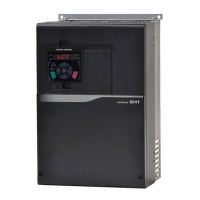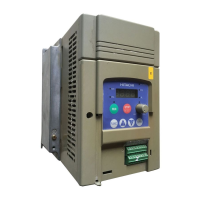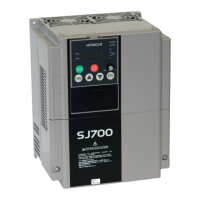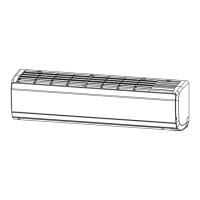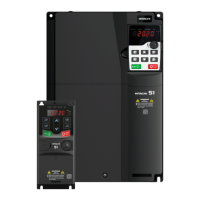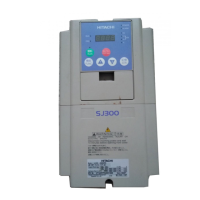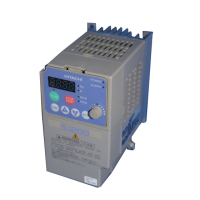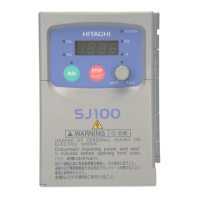Inspection and maintenance
6.2 Daily and periodic inspections
*1) The life span of the smoothing capacitor is influenced by the
ambient temperature. Refer to [Smoothing capacitor life span
curve] for replacing measures.
*2) The life span of the cooling-fan is influenced by the ambient
temperature, the dirt and the change in its environmental
conditions. Check these circumstances on the usual inspection.
*3) The estimated time before replacement (Number of years/cycle) and
the [Smoothing capacitor life span curve] are based on the design
lifespan, not guaranteed.
*4) In the case that the capacitors are replaced after that the storage
period of 3 years has expired, perform aging under the following
conditions before using the inverter:
・First, apply for 1 hour the 80% of the capacitor rated voltage at
ambient temperature.
・Then, raise the voltage to 90%, and keep it for 1 more hour.
・Finally, apply for 5 hours the rated voltage at ambient temperature.
*5) If the cooling fan is locked due to dust, etc., it takes 5 to 10 seconds
to restart even if dust is removed.
*6) Follow the instruction manual for the motor.
Check the ambient temperature,
level of humidity, dust, … etc..
Refer to Chapter 2
”Installation and Wiring” .
Ambient temperature, level of
humidity are withing the range.
No frozen part. No
condensation.
Thermometer.
Hygrometer.
Data logger.
Check that there are no abnormal
vibrations or noises.
Check visually and auditorily.
Check that the main circuit voltage
is normal.
Measure the line-to-line
voltage of the inverter main
circuit terminals R,S and T.
Within the AC voltage
permissible variation.
Multimeter.
Digital
multimeter.
(1)Check the resistance between the
main circuit and the ground terminals.
Remove the inverter main
circuit terminals input/output
wiring and the control terminal
board, and remove the jumper
for the internal filter, after
that, shortcircuit the terminals
R,S,T,U,V,W,P,PD,N,RB,R0,T0,
and measure between this
shortcircuit and the ground.
Resistance no less than 5MΩ.
DC 500V class
Ohmmeter.
(megger®)
(2)Check looseness in fastened parts.
Confirm tighten of fasteners.
(3)Check for overheating traces.
(1)Check for straining in conductors.
(2)Check for cable coating damage.
Inverter and
converter
circuits
(Including
resistors)
Check the resistance between all the
terminals.
Remove the inverter main
circuit terminal wiring, and
measure the following:
- Resistance between
terminals RST and PN.
- Resistance between
terminals UVW and PN
Refer the “6.5 Checking
method for inverter/
converter ”. The inverter,
capacitor and thyristor lifespan
before replacing the
componentes is of 10
6
start/stop cycles. *3)
(1)Check for capacitor fluid leakage
No abnormality.
Estimated years life span
before exchanging component:
10 years.
*1) *3) *4)
(2)Check that the relief valve does not
swells or protudes.
(1)No chatter sound while operating.
(2)Check contacts for damage.
Control and
protection
circuits
(1) While performing a unit operation
of the inverter, check the balance of
the output voltage among the
individual phases.
Measure the voltage between
the U,V,W terminals of the
inverter main circuit.
Phase-to-phase voltage
balance 200V class: within 4V.
400V class: within 8V.
Digital
multimeter.
Voltmeter.
Ammeter.
(2)Carry out a sequential protection
test, and check the protective and
display circuits for any abnormality.
Simulate a shortcircuit or open
of the inverter output
protection circuit.
An error must be detected
according to the sequence.
(1) Check that there are no abnormal
vibrations or noises.
Turn by hand while electricity
is not being supplied.
Smooth operation.
No abnormality.
Replace every: 10 years.
*2) *3) *5)
(2)Check for loose joints.
Check for obstructions/clogging.
Chack that there is no clogging.
(1) Check if the charge lamp LED and
the Keypad’s LEDs and LCD light up.
Check that Indicated values are
normal.
Check the meters readings on
the control panel.
Regulation and control value
are satisfactory.
(1)Check that there are no abnormal
vibrations or noises.
Check visually,auditorily, and
by touch.
(2)Check that there is no odour.
Check for abnormal
superheating, damages an so
on.
Check the resistance between the
main circuit and the ground
terminals.
Detach the U,V,W terminals
from the inverter main circuit,
and shortcircuit the motor
wiring, mesure with the
Megger® between the motor
wiring and ground terminal.
DC 500V class
Ohmmeter.
(megger®)

